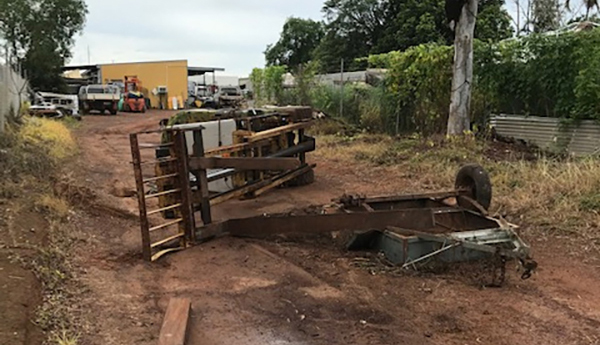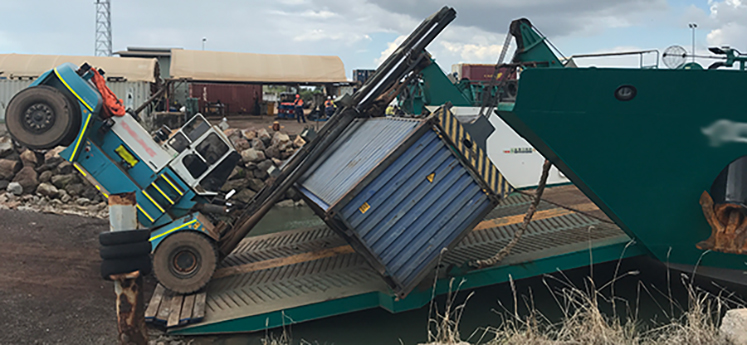Forklift stability when carrying loads
The purpose of this Safety Alert is to remind forklift owners, operators, and workers of the hazards associated with operating forklifts, in particular on uneven ground with elevated heavy and large dimension loads, and to reinforce the use of well-established ways to minimise the risk of injury from tipping over.
Background
WorkSafe Inspectors have responded to two forklift tip over incidents within two weeks, in Darwin.
The first incident occurred in late March 2021, when an unlicensed operator was reversing a forklift along a rough dirt driveway carrying a trailer frame. The forklift was reversing with the tines raised at the top of the mast when the forklift tipped over onto its side. The operator received a serious laceration to their arm that required 32 stitches.

The second incident occurred in early April 2021, when a recently licensed, and inexperienced forklift operator attempted to unload a 40 foot shipping container from a vessel. The shipping container had to be elevated to clear the vessel’s bow as the forklift reversed down the bow ramp.
As the forklift attempted to reverse up the boat ramp, the 37 tonne forklift tipped forward damaging the vessel, shipping container and forklift. Fortunately the operator escaped without injury.
Possible contributing factors
- The forklifts were travelling on uneven ground or an incline when the tip over occurred.
- Both forklifts were travelling with the loads lifted high, which can affect the stability of the forklift.
- The loads being carried in in both incidents may have contributed to the incident:
- In the first incident, the trailer frame was not secured and was able to swing on the tines;
- In the second incident, the aftermarket weighing system fitted to the forklift did not register a reading when the shipping container was lifted. During the retrieval process, the shipping container and its contents was found to have exceeded the forklifts rated capacity.

Action required
- Operators must hold the appropriate high risk work licence before operating a forklift and inexperienced operators should be appropriately supervised.
- Operators must wear the seatbelt (if fitted). Seatbelts can be retrofitted to forklifts without them.
- Before moving a load, the operator should check that the load is secured and the weight is within the forklifts rated capacity.
- Businesses must ensure that all aftermarket equipment installed is suitable for the task at hand, and all operators are competent in using the installed equipment.
- Operators should be aware that when a load is raised, the forklift is less stable;
- Tilting forwards or backwards with a raised load will also affect the forklifts stability.
- Operators should avoid travelling with a raised load, as this makes the forklift less stable and leads to tipping over, particularly if the forklift is travelling at speed, around a corner, or on an uneven surface.
- Loads should be lowered just above the ground with the mast tilted back before moving.
- When operating the forklift on an incline, the load must be tilted back and raised only as far as needed to clear the ground. The load must be facing up the incline. Do not try to turn on an incline.
- If the work environment is not safe to properly operate a forklift, consider using alternative equipment to move the load.
Further information
For further information, please refer to the following:
Safety Alerts
- Forklift load handling (WorkSafe NSW)
Guide
Disclaimer
This Safety Alert contains safety information following inquires made by NT WorkSafe about an incident or unsafe practice. The information contained in this Alert does not necessarily include the outcome of NT WorkSafe’s action with respect to an incident. NT WorkSafe does not warrant the information in this Alert is complete or up-to-date and does not accept any liability for the information in this report or as to its use.